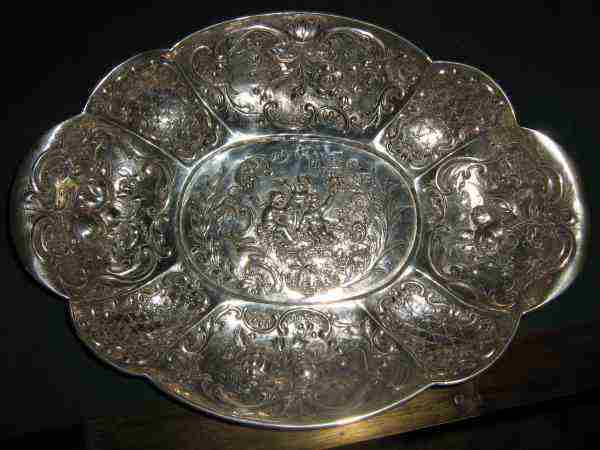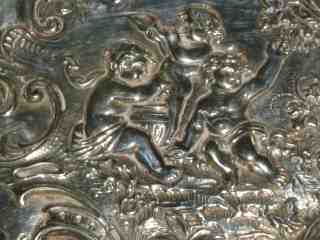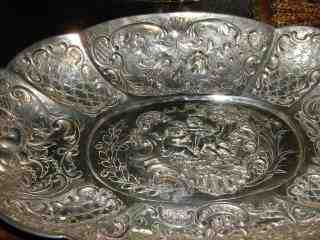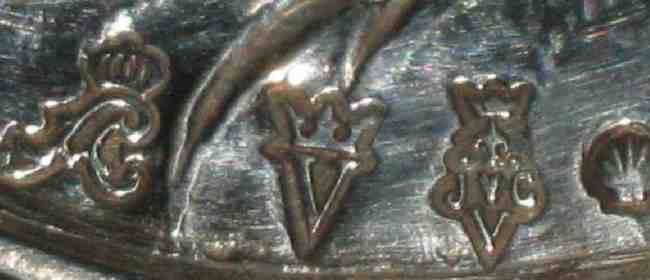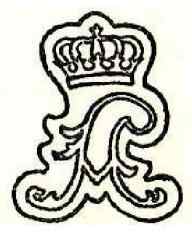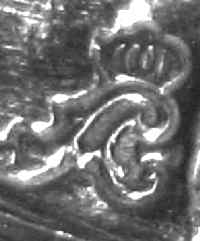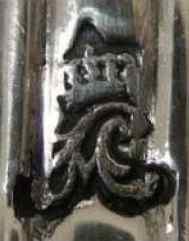A SMALL COLLECTION OF ANTIQUE SILVER |
| an article of Christophe Ginter, for ASCAS - Association of Small Collectors of Antique Silver |

|
(click on photos to enlarge image)AN IMITATION OF LOUIS XV HALLMARKSIn this page I analyze the hallmarks of a silver sweetmeat dish decorated with rich embossing of cherubs and floral motifs, apparently marked with French 18th century hallmarks.If these marks were genuine, they represent (from left to
right:
|
(2) On the "poinçon de Jurande" (warranty
mark) (note 2)
|
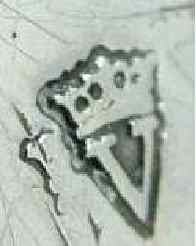 |
(3) On the poinçon de l'orfèvre (maker's mark)
(note 3)
The counterfeiter commits a blunder. The silversmith VARLET
worked in Saint-Germain, and, at that time, this city had its
own "poinçons de Charge, Décharge et de Jurande", different from
those used in Paris!
For example, the "poinçons de Charge" should be an ermine
on two crossed branches of laurel. In addition, the "fleur de
lys" (amid initials and crown) is very crudely drawn, probably
by someone not familiar with the design of this symbol.
Finally, the maker's initials are very thin (they should be
larger).
(4) On the poinçon de Décharge (la coquille: the shell)
(note 4)
This symbol was in use only for small objects and certainly was
never used for a dish. Sometimes, the official appointed to
verify the collection of duty charges used the mark of "large
objects" instead of that of "small objects", but such "mistakes"
are found only on cutlery and never on a dish.
(5) Final remarks
- the placing of marks in this order is contrary to the rules of
logic, as maker's mark and "poinçons de charge" should be side
by side;
- mark's outline (distance between the symbol and punch's edge)
is too clearly defined and highly suspicious;
- finally, the object itself: heavy chiselling and embossing
vaguely inspired to country life in Chinese style (?) without no
link to Louis XV taste nor in line with technical workmanship of
most of French silversmiths.
ENDNOTES
(note 1): was struck at the early beginning of the sketch. This
mark meant that the piece had been declared to the tax
authorities. Hence, this mark should be found side by side with
the maker's mark. Its size was large, similar to the maker's
mark.
(note 2): this mark certified the silver content
(958/1000 in Paris). The mark was an "alphabetic letter under an
open crown", changed yearly. This allowed one to determine the
precise year of the sale. All the letters were used, except "J"
and "W". Furthermore, the "U" wasn't used under the Louis XV
reign.
(note 3): was the first mark to be struck, when the item
was still a rough sketch. The maker's mark was stamped together
with the "poinçon de Charge"
(note 4): was struck when tax was paid. Its size was
roughly half as large as that of the Charge mark.
Christophe Ginter
|
 www.silvercollection.it |
|
This is a page of A Small Collection of
Antique Silver and Objects of vertu, a 1500 pages richly illustrated website offering all you need to know about
antique silver, sterling silver, silverplate, Sheffield plate, electroplate silver,
silverware, flatware, tea services and tea complements, marks and hallmarks, articles,
books, auction catalogs, famous silversmiths (Tiffany, Gorham, Jensen, Elkington),
history, oddities ... HOME - SITE MAP - SILVER DICTIONARY - COOKIES CONSENT AND PRIVACY OTHER ARTICLES ABOUT: ANTIQUE SILVER SILVER PLATE ENGLISH SILVER FRENCH SILVER |
